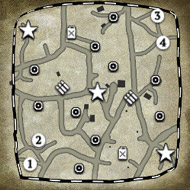Skins cannot really change the geometry, but they can change transparency. The basic texture maps that are painted include diffuse color, specularity, gloss, bump, and alpha. I expect that 99% of skins don't change the bump and alpha maps, but by carefully painting these you can create the effect of an open mesh like the ones on the side skirts pictured above. Removing a specific piece of geometry by painting the map to make it transparent is pretty easy.
Correct. Simply find the part of the model on the diffuse map you want to make "disappear", then paint it black in the alpha map. Pretty easy way to create the mesh side skirts, remove track guards, remove wheel on side of Hetzer, etc...
I'm pretty sure I had included the mesh skirts for the curated skin pack. However, I think Relic removed them unfortunately for the final release.
Btw, great job on the database CasTroy. Very helpful.






























































































 The British Forces
The British Forces 



















































 cblanco ★
cblanco ★  보드카 중대
보드카 중대  VonManteuffel
VonManteuffel  Heartless Jäger
Heartless Jäger 